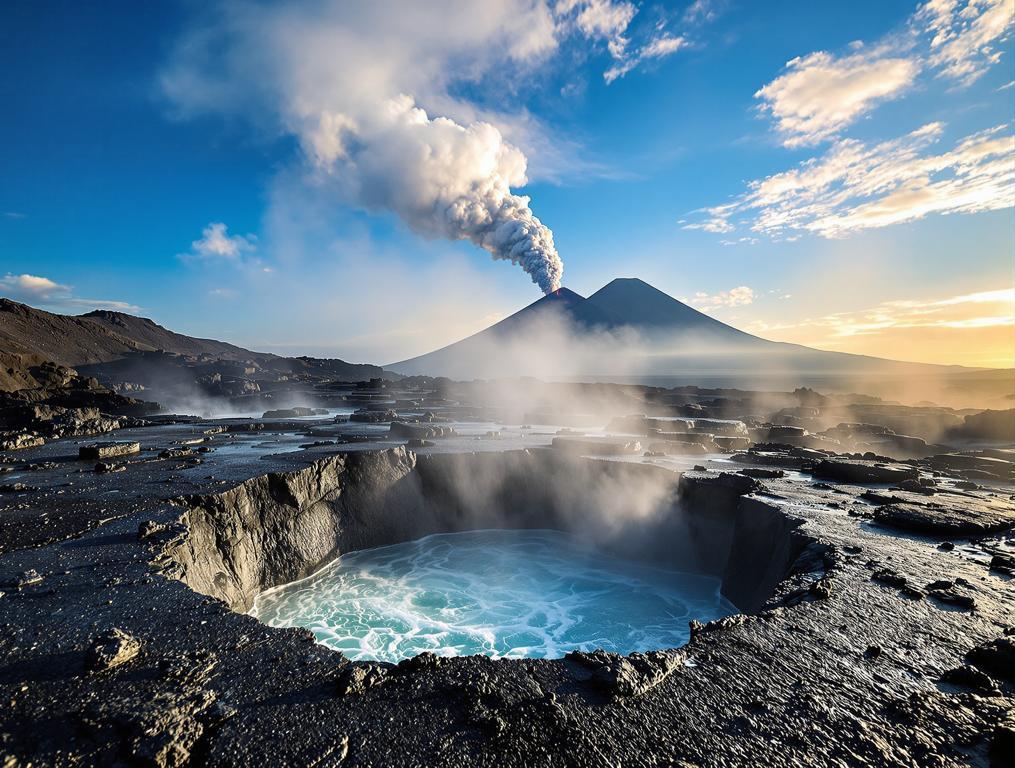I dip my toes into the volcanic ash footbath as Sakurajima’s peak rumbles in the distance. A plume of gray smoke rises lazily against the blue summer sky, visible from this 100-meter-long thermal pool carved into black volcanic rock. In the same moment that my shoulders relax into the therapeutic warmth, Japan’s most active volcano releases another gentle eruption – the third I’ve witnessed since arriving just two hours ago. This paradox defines Sakurajima: a place where 4,000 residents have mastered the art of finding wellness alongside danger.
Japan’s Secret Volcanic Spa: Where Daily Eruptions Meet Ancient Healing
The Yogan Nagisa Park footbath stretches before me, filled with geothermally heated water infused with mineral-rich volcanic ash. Children splash at one end while elderly locals soak weather-worn feet at the other – all while keeping one eye on the smoking mountain above.
“This is our normal,” explains my guide, pointing toward the peak. “We don’t see danger – we see energy.” This sentiment isn’t metaphorical. The same volcanic forces powering these footbaths also produce multiple daily eruptions, creating a wellness experience impossible to replicate elsewhere.
Unlike Iceland’s commercialized Blue Lagoon or Italy’s distant Stromboli, Sakurajima offers something utterly unique: a Japanese cultural integration of volcanic power into daily wellness rituals. The peninsula sits just 4 kilometers across Kagoshima Bay from a major city, making this perhaps the world’s most accessible active volcano experience.
After soaking, I follow a path through lush summer vegetation thriving in volcanic soil to a modest pottery workshop. Here, craftsmen mix volcanic ash into clay, creating distinctive vessels with earthy textures. When I lift one, the weight feels substantial – grounding, like the landscape itself.
How Sakurajima’s Living Volcano Outshines Europe’s Famous Thermal Sites
While Tenerife provides Europe’s own volcanic paradise with dramatic landscapes, Sakurajima delivers what volcano enthusiasts truly crave: active, daily eruptions with cultural immersion. Unlike Italy’s Stromboli, which requires complex travel arrangements to reach, Sakurajima welcomes visitors via a 15-minute ferry that runs 24/7.
“We bathe in ash-enriched waters while watching the mountain smoke. Nowhere else can you experience such peaceful danger – it’s the Japanese way to find beauty in impermanence.”
This philosophy extends beyond the footbaths. At local markets, farmers sell enormous daikon radishes and sweet komikan citrus, both nurtured by mineral-rich volcanic soil. Their size and flavor are direct products of Sakurajima’s continuous ash deposits – an agricultural blessing disguised as inconvenience.
Unlike Idaho’s famous hot springs which produce millions of gallons daily, Sakurajima’s footbaths offer something more profound: the chance to witness earth’s raw power while experiencing its gentle healing properties simultaneously.
Similar to how California’s geological marvel towns have adapted to seismic realities, Sakurajima’s inhabitants have developed unique relationships with their volatile neighbor. But here, that relationship centers on wellness traditions that transform potential threat into healing practice.
What the Guidebooks Won’t Tell You About Visiting in Summer 2025
For optimal volcano viewing, arrive at the Yunohira Observatory before 10:00 AM when air clarity peaks and most tour buses haven’t yet arrived. The 15-minute ferry from Kagoshima Port departs every 10 minutes with the first morning crossing offering the best photographs of steam against dawn light.
While Hawaii offers unique microclimates, Sakurajima creates its own weather patterns with summer temperatures 2-3°C cooler than mainland Kagoshima – perfect for exploring the Lava Coast Walking Trail which most visitors miss entirely.
For an authentic experience, time your footbath soak for late afternoon when locals gather to discuss the day’s events while watching for eruptions. The water temperature reaches its ideal 42°C around 4:00 PM as residual daytime heat combines with geothermal energy.
As the ferry carries me back to Kagoshima, Sakurajima offers one final eruption – a gentle puff that sends ash drifting skyward like incense smoke from a temple. My daughter Emma would call this “mountain breath,” and she wouldn’t be wrong. The Japanese concept of wabi-sabi – finding beauty in imperfection and impermanence – seems perfectly embodied in this place where danger and healing spring from the same source. Some destinations teach us to conquer nature; Sakurajima teaches us to bathe in its power instead.
